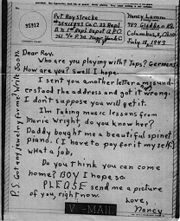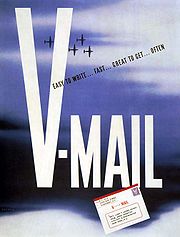
V-mail
Encyclopedia



Hybrid mail
Hybrid mail is mail that is delivered using a combination of electronic and physical delivery. Usually, it involves digital data being transformed into physical letter items at distributed print centres located as close as possible to the final delivery addresses...
process used during the Second World War in America as the primary and secure method to correspond with soldiers stationed abroad. To reduce the logistics of transferring an original letter across the military postal system
Military mail
A primary feature of military mail systems is that normally they are subsidized to ensure that military mail posted between duty stations abroad and the home country does not cost the sender any more than normal domestic mail traffic...
, a V-mail letter would be censored, copied to film, and printed back to paper upon arrival at its destination. The V-mail process is based on the earlier British Airgraph process.
Operation and Function
V-mail correspondence was on small letter sheetsLetter sheet
In philatelic terminology a Letter sheet, often written lettersheet, is nowadays an item of postal stationery issued by a postal authority. It is a sheet of paper that can be folded, usually sealed , and mailed without the use of an envelope...
, 17.8cm by 23.2cm (7 by 9 1/8 in.), that would go through mail censors
Postal censorship
Postal censorship is the inspection or examination of mail, most often by governments. It can include opening, reading and total or selective obliteration of letters and their contents, as well as covers, postcards, parcels and other postal packets. Postal censorship takes place primarily but not...
before being photographed and transported as thumbnail-sized image in negative microfilm. Upon arrival to their destination, the negatives would be blown up to 60% their original size 10.7cm by 13.2cm (4 ¼ in. by 5 3/16 in.) and printed.
According to the National Postal Museum, "V-mail ensured that thousands of tons of shipping space could be reserved for war materials. The 37 mail bags required to carry 150,000 one-page letters could be replaced by a single mail sack. The weight of that same amount of mail was reduced dramatically from 2,575 pounds to a mere 45." This saved considerable weight and bulk in a time in which both were hard to manage in a theatre of the war.
In addition to postal censorship, v-mail also deterred espionage communications by negating the use of invisible ink
Invisible ink
Invisible ink, also known as security ink, is a substance used for writing, which is invisible either on application or soon thereafter, and which later on can be made visible by some means. Invisible ink is one form of steganography, and it has been used in espionage...
s, microdot
Microdot
A microdot is text or an image substantially reduced in size onto a 1mm disc to prevent detection by unintended recipients. Microdots are normally circular around one millimetre in diameter but can be made into different shapes and sizes and made from various materials such as polyester...
s, and microprinting
Microprinting
Microprinting is one of many anti-counterfeiting techniques used most often on currency and bank checks, as well as various other items of value. Microprinting involves printing very small text, usually too small to read with the naked eye, onto the note or item. Microprint is frequently hidden in...
, all of which would not be photographed.
British 'Airgraph'
The airgraph was invented in the 1930s by the Eastman Kodak Company in conjunction with Imperial Airways (now British Airways) and Pan-American Airways as a means of reducing the weight and bulk of mail carried by air. The airgraph forms, upon which the letter was written, were photographed and then sent as negatives on rolls of microfilm. A General Post Office (GPO) poster of the time claimed that 1,600 letters on film weighed just 5oz, while 1,600 ordinary letters weighed 50 lbs. At their destination the negatives were printed on photographic paper and delivered as airgraph letters through the normal Royal EngineersRoyal Engineers
The Corps of Royal Engineers, usually just called the Royal Engineers , and commonly known as the Sappers, is one of the corps of the British Army....
(Postal Section), also known as the Army Postal Services (APS), or systems.
In 1940 the British Minister of Transport, Lieutenant Colonel John Moore-Brabazon, 1st Baron Brabazon of Tara
John Moore-Brabazon, 1st Baron Brabazon of Tara
John Theodore Cuthbert Moore-Brabazon, 1st Baron Brabazon of Tara, GBE, MC, PC was an English aviation pioneer and Conservative politician...
, put forward the idea that airgraphs be used to reduce both the bulk and weight of mail travelling between the Middle East Force (MEF) and the UK. The matter was referred to the APS and the GPO, who jointly investigated the possibility of using airgraphs. This eventually led to a service being instituted between England and Egypt in 1941 when 70,000 airgraphs were sent in the first batch and took three weeks to reach their destination.
Kodak had offices in Cairo that were capable of processing airgraph negatives, but it was not until the appropriate equipment arrived from America that their Cairo office that the APS was able to provide a return service to the UK.
In the theatres of war the whole airgraph operation was coordinated by the APS. Completed airgraph forms were collected by the A/FPOs and forwarded to the Kodak processing plants, which were co-located with the Base APOs.
The use of the airgraph was not rationed and its postage was also set at three pence (3d). Although the airgraph proved to be immediately popular its use was limited because of its size (approx; 2ins × 3ins) and lack of privacy, so when sufficient aircraft capacity became available its use declined in favour of the air letter.
The airgraph service was later extended to: Canada (1941), East Africa (1941), Burma (1942), India (1942), South Africa (1942), Australia (1943), New Zealand (1943) Ceylon (1944) and Italy (1944).
Historical antecedents
The U.S. military's V-mail was based on British Airgraphs, which were based on Eastman KodakEastman Kodak
Eastman Kodak Company is a multinational imaging and photographic equipment, materials and services company headquarted in Rochester, New York, United States. It was founded by George Eastman in 1892....
's patent obtained from New York City banker George McCarthy. Prior to that, a similar system was deployed during the Franco-Prussian War
Franco-Prussian War
The Franco-Prussian War or Franco-German War, often referred to in France as the 1870 War was a conflict between the Second French Empire and the Kingdom of Prussia. Prussia was aided by the North German Confederation, of which it was a member, and the South German states of Baden, Württemberg and...
which used carrier pigeon
Carrier pigeon
A carrier pigeon is a homing pigeon that is used to carry messages. Using pigeons to carry messages is generally called "pigeon post". Most homing or racing type varieties are used to carry messages. There is no specific breed actually called "carrier pigeon"...
s to send primitive microfilm strips across German lines, developed from French optician René Dagron
René Dagron
René Prudent Patrice Dagron was a French photographer and inventor. He was born in Aillières-Beauvoir, Sarthe, France....
's first patent granted for microfilm in 1859. Dagron's microfilm patent was additionally based on British scientist John Benjamin Dancer
John Benjamin Dancer
John Benjamin Dancer was a scientific instrument maker and inventor of microphotography. He also pioneered stereography. By 1835, he controlled his father's instrument making business. He was responsible for various inventions, but did not patent many of his ideas. In 1852, he invented the...
, who created microfilm in 1839.
See also
- MicroformMicroformMicroforms are any forms, either films or paper, containing microreproductions of documents for transmission, storage, reading, and printing. Microform images are commonly reduced to about one twenty-fifth of the original document size...
- AirmailAirmailAirmail is mail that is transported by aircraft. It typically arrives more quickly than surface mail, and usually costs more to send...
- British Forces Post OfficeBritish Forces Post OfficeThe British Forces Post Office provides a postal service to HM Forces, separate from that provided by Royal Mail in the United Kingdom. BFPO addresses are used for the delivery of mail in the UK and around the world...
- Hybrid mailHybrid mailHybrid mail is mail that is delivered using a combination of electronic and physical delivery. Usually, it involves digital data being transformed into physical letter items at distributed print centres located as close as possible to the final delivery addresses...
- Print-to-mail
External links
- V-Mail Object of the Month National Postal MuseumNational Postal MuseumThe National Postal Museum, located opposite Union Station in Washington, D.C., USA, was established through joint agreement between the United States Postal Service and the Smithsonian Institution and opened in 1993. The museum is located across the street from Union Station, in the building that...
, Smithsonian InstitutionSmithsonian InstitutionThe Smithsonian Institution is an educational and research institute and associated museum complex, administered and funded by the government of the United States and by funds from its endowment, contributions, and profits from its retail operations, concessions, licensing activities, and magazines... - Royal Engineers Museum Army Postal Services (1939–45) - origins of British Airgraph

